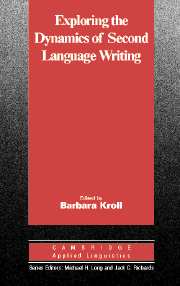Book contents
- Frontmatter
- Contents
- List of contributors
- Acknowledgments
- List of abbreviations used
- Series editors' preface
- Introduction: Teaching the next generation of second language writers
- I EXPLORING THE FIELD OF SECOND LANGUAGE WRITING
- II EXPLORING THE VOICES OF KEY STAKEHOLDERS:TEACHERS AND STUDENTS
- Chapter 3 Experienced ESL/EFL writing instructors' conceptualizations of their teaching: Curriculum options and implications
- Chapter 4 Second language writing up close and personal: Some success stories
- III EXPLORING WRITERS' FINISHED TEXTS
- IV EXPLORING CONTEXTUALITIES OF TEXTS
- V EXPLORING TECHNOLOGY
- EPILOGUE: EXPLORING OURSELVES
- Index
Chapter 4 - Second language writing up close and personal: Some success stories
Published online by Cambridge University Press: 05 October 2012
- Frontmatter
- Contents
- List of contributors
- Acknowledgments
- List of abbreviations used
- Series editors' preface
- Introduction: Teaching the next generation of second language writers
- I EXPLORING THE FIELD OF SECOND LANGUAGE WRITING
- II EXPLORING THE VOICES OF KEY STAKEHOLDERS:TEACHERS AND STUDENTS
- Chapter 3 Experienced ESL/EFL writing instructors' conceptualizations of their teaching: Curriculum options and implications
- Chapter 4 Second language writing up close and personal: Some success stories
- III EXPLORING WRITERS' FINISHED TEXTS
- IV EXPLORING CONTEXTUALITIES OF TEXTS
- V EXPLORING TECHNOLOGY
- EPILOGUE: EXPLORING OURSELVES
- Index
Summary
“All of us who have tried to write something in a second language … sense that the process of writing in an L2 is startlingly different from writing in our L1.”
(Raimes, 1985)Different indeed, but what is important for second language (L2) writing professionals is precisely how this difference manifests itself in second language writing. Questions about the distinct nature of L2 writing have driven a great deal of research in L2 writing studies (see Silva, 1993, for an overview and synthesis of some of this research). Researchers in second language writing have approached these questions in different (but all quite valid) ways with regard to who tells the story of this difference: in most such studies only the researcher speaks, reporting on and interpreting observations about L2 writers and/or L2 writing (for example, Hyland & Milton, 1997); others observe and interpret, too, but also use quotations from L2 writers to a greater or lesser extent to illustrate their (the researchers') points and warrant their claims (for example, Silva, 1992). However, only recently have L2 writers been given an opportunity to tell their own stories. (See Belcher and Connor, 2001, and Connor, 1999, who give voice to multiliterate writers; see also Belcher and Hirvela, 2001, who, in a related project, examine the notion of voice in L2 writing.) Such stories are told in a variety of research designs as well (see Polio, Chapter 2 this volume).
- Type
- Chapter
- Information
- Exploring the Dynamics of Second Language Writing , pp. 93 - 114Publisher: Cambridge University PressPrint publication year: 2003
- 5
- Cited by



